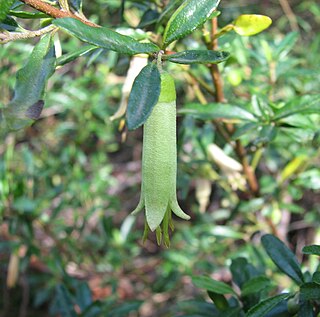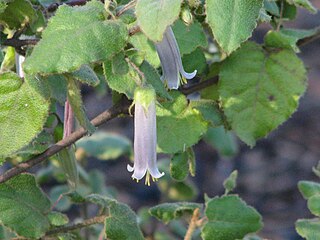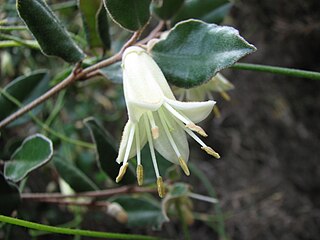
Banksia oreophila, commonly known as the western mountain banksia or mountain banksia, is a species of shrub that is endemic to the south-west of Western Australia. It has glabrous stems, wedge-shaped or narrow egg-shaped leaves with the narrower end towards the base, cylindrical spikes of pale pink to mauve flowers and later, up to twenty follicles in each spike, surrounded by the remains of the flowers. It occurs on slopes and hilltops in the Stirling and Barren Ranges.

Correa baeuerlenii, commonly known as chef's-hat correa, is a species of dense, rounded shrub that is endemic to the south-east of New South Wales. It has egg-shaped leaves and pendulous, greenish yellow flowers usually arranged singly on short side branches.

Correa lawrenceana, commonly known as mountain correa, is a species of shrub or small tree of the family Rutaceae and is endemic to Australia. It has elliptical to egg-shaped leaves arranged in opposite pairs and cylindrical, greenish yellow to red flowers usually arranged singly or in groups of up to seven in leaf axils with the stamens protruding beyond the end of the corolla.

Correa calycina, commonly known as the South Australian green correa or Hindmarsh correa, is a species of tall, dense shrub that is endemic to a small area of South Australia. It has papery, oblong leaves and pendulous green flowers arranged singly on the ends of short side branches.

Correa glabra, commonly known as the rock correa, is a species of tall, erect shrub that is endemic to Australia. It usually has elliptical, mostly glabrous leaves and pendent, pale green to pale yellow flowers arranged singly on short side shoots.

Correa aemula, commonly known as the hairy correa, is a species of shrub that is endemic to south-eastern Australia. It has broadly heart-shaped leaves arranged in opposite pairs, green or greyish green, pendent flowers arranged singly or in pairs and ageing to mauve-purple.

Correa backhouseana is a species of rounded shrub that is endemic to coastal and near-coastal areas of southern Australia. It has elliptical to egg-shaped or round leaves that are densely hairy on the lower surface, and cylindrical to funnel-shaped, cream-coloured to pale green or red and yellow flowers.

Correa decumbens, commonly known as the spreading correa, is a species of prostrate to spreading shrub that is endemic to South Australia. It has narrow oblong to narrow elliptical leaves and narrow cylindrical, pink to red flowers with green lobes.
Correa eburnea, commonly known as the Deep Creek correa, is a species of shrub that is endemic to the Fleurieu Peninsula in South Australia. It has papery, elliptic to egg-shaped leaves, and up to five green, nodding flowers arranged in leaf axils.

Acacia howittii, commonly known as sticky wattle or Howitt's wattle, is a tree species that is endemic to Victoria, Australia.
Philotheca pungens, commonly known as prickly waxflower, is a species of flowering plant in the family Rutaceae and is endemic to south-eastern Australia. It is an undershrub with linear to narrow oblong or needle-like leaves and white flowers usually arranged singly in leaf axils.

Leptospermum obovatum, commonly known as river teatree, is a species of shrub that is endemic to south-eastern continental Australia. It has egg-shaped or lance-shaped leaves that are narrower at the base, white flowers usually arranged singly on short side shoots and fruit that remains on the plant until it dies.
Leptospermum sericeum, commonly known as the silver tea tree, is a species of shrub that is endemic to the south-west of Western Australia. It has thin, firm bark, egg-shaped leaves with the narrower end towards the base, relatively large, pink flowers and fruit that fall from the plant with the seeds. It grows in windswept rock crevices near Esperance.

Boronia pulchella, commonly known as the pink boronia, is a plant in the citrus family, Rutaceae and is endemic to a small area in the south-west of Western Australia. It is a slender shrub with rod-like stems, pinnate leaves and deep pink, four-petalled flowers.

Boronia rhomboidea, commonly known as the broad-leaved boronia or rhomboid boronia, is a plant in the citrus family Rutaceae and has a disjunct distribution in New South Wales and Tasmania in Australia. It is an erect, woody shrub with many branches, simple, broadly egg-shaped to almost circular leaves and groups of up to three white to pale pink, four-petalled flowers on the ends of the branches or in the axils of the upper leaves.
Eucalyptus sweedmaniana is a sprawling to prostrate mallee that is endemic to a small area in the Cape Arid National Park in Western Australia. It has smooth, silvery grey bark, broadly lance-shaped, glossy green adult leaves, single red, pendulous flower buds in leaf axils, pink flowers and prominently winged fruit.

Correa lawrenceana var. cordifolia, commonly known as the pink mountain-correa, is a variety of Correa lawrenceana and is endemic to south-eastern Australia. It is a shrub with leathery, broadly egg-shaped to heart-shaped leaves, and pink flowers with yellowish tips arranged singly or in groups of two or three in leaf axils.
Correa lawrenceana var. genoensis, commonly known as the Genoa River correa, is a variety of Correa lawrenceana and is endemic to south-eastern Australia. It is a shrub with egg-shaped leaves and yellowish green flowers usually arranged singly in leaf axils.

Correa lawrenceana var. lawrenceana is the implicit autonym of Correa lawrenceana and is endemic to Tasmania. It is a shrub with papery, oblong leaves and pale green, narrow cylindrical flowers arranged singly on the ends of branchlets.
Correa lawrenceana var. rosea is a variety of Correa lawrenceana that is endemic to the Snowy Mountains of New South Wales. It is a shrub with narrow elliptical leaves and narrow cylindrical flowers that are pink or dull red with green lobes and covered with small, compact star-shaped hairs.














